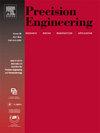Study on the effect of dispersed phase particle functional groups on the polishing performance of shear-thickening polishing slurry
IF 3.5
2区 工程技术
Q2 ENGINEERING, MANUFACTURING
Precision Engineering-Journal of the International Societies for Precision Engineering and Nanotechnology
Pub Date : 2025-03-04
DOI:10.1016/j.precisioneng.2025.03.002
引用次数: 0
Abstract
This paper compares three types of dispersed phases—Phosphate Ester-Bis-Polyhydroxy Polymers, Hydroxypropyl-Bis-Polyhydroxy Phosphate Esters, and General Polyhydroxy Polymer—all of which are produced in large quantities on an industrial scale. The effect of different dispersed phase functional groups on Shear Thickening Polishing performance was investigated. Rheological properties were measured for Shear Thickening Fluids with various dispersed phase configurations, revealing that dispersed phases with hydroxypropyl functional groups exhibited superior rheological properties. The differences in viscosity among the experimental groups were explained using double stacking theory and particle size distribution, derived from the volume fraction of suspended particles. Furthermore, in Shear Thickening Polishing Fluid with different dispersed phase configurations, a new mechanism explaining changes in shear thickening behavior was proposed based on the distinct characteristics of the three dispersed phases. Measurements of polishing force and temperature during the polishing process, combined with SEM image comparisons, showed that dispersions containing phosphate functional groups demonstrated superior temperature resistance. Finally, the polishing performance was validated on YAG crystals, concluding that phosphate ester functional groups give the dispersed phase better temperature resistance for long polishing times, while hydroxypropyl functional groups give the dispersed phase better rheological properties for higher demands on polishing precision.

分散相颗粒官能团对剪切增稠抛光浆抛光性能影响的研究
本文比较了三种分散相——磷酸酯-双聚羟基聚合物、羟丙基-双聚羟基磷酸酯和普通多羟基聚合物——它们都是在工业规模上大量生产的。研究了不同分散相官能团对剪切增厚抛光性能的影响。对具有不同分散相构型的剪切增稠液进行了流变性能测试,结果表明具有羟丙基官能团的分散相具有较好的流变性能。用双堆积理论和由悬浮颗粒体积分数导出的粒径分布来解释各组间粘度的差异。此外,在具有不同分散相结构的剪切增稠抛光液中,基于三种分散相的不同特性,提出了剪切增稠行为变化的新机制。抛光过程中的抛光力和温度测量,结合SEM图像比较,表明含有磷酸盐官能团的分散体具有优异的耐温性。最后,对YAG晶体的抛光性能进行了验证,得出磷酸酯官能团使分散相具有更好的耐温性和较长的抛光时间,而羟丙基官能团使分散相具有更好的流变性能,对抛光精度有更高的要求。
本文章由计算机程序翻译,如有差异,请以英文原文为准。
求助全文
约1分钟内获得全文
求助全文
来源期刊
CiteScore
7.40
自引率
5.60%
发文量
177
审稿时长
46 days
期刊介绍:
Precision Engineering - Journal of the International Societies for Precision Engineering and Nanotechnology is devoted to the multidisciplinary study and practice of high accuracy engineering, metrology, and manufacturing. The journal takes an integrated approach to all subjects related to research, design, manufacture, performance validation, and application of high precision machines, instruments, and components, including fundamental and applied research and development in manufacturing processes, fabrication technology, and advanced measurement science. The scope includes precision-engineered systems and supporting metrology over the full range of length scales, from atom-based nanotechnology and advanced lithographic technology to large-scale systems, including optical and radio telescopes and macrometrology.

 求助内容:
求助内容: 应助结果提醒方式:
应助结果提醒方式:


